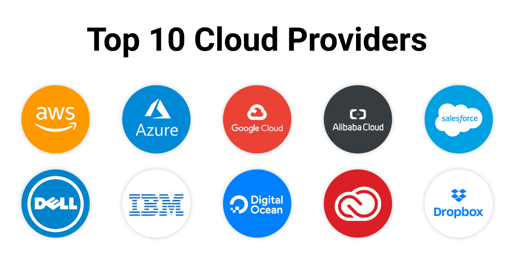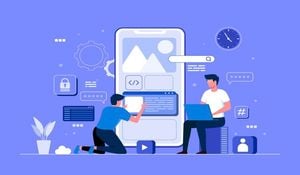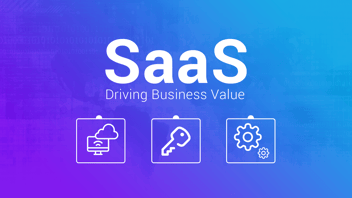What Is SaaS? Everything You Need to Know About SaaS

The Software-as-a-Service (SaaS) sector is one of the fortunate ones, having not only survived the pandemic but also grown and attracted new clients and investments. This evolution was driven by diversity. Artificial Intelligence, augmented reality/virtual reality, low-code/no-code SaaS, vertical SaaS, and enhanced mobile optimization are considered the most popular SaaS trends.
Many people who use SaaS applications in their daily work aren't even aware of what it entails. SaaS software is analogous to subscribing to a natural gas service supplied via a pipe to your home rather than purchasing and storing gas cylinders at home. With cloud computing, you can subscribe to the SaaS services you require rather than purchasing and installing the programs on your computer. The SaaS service is accessible on-demand, anytime you want it. You just pay for what you use with optional price options based on your use requirements. The service is scalable. You don't run out no matter how much you require. You can disable the service at any moment.
Salesforce coined the phrase "SaaS," which refers to allowing users to pay for software on a subscription basis, much like a monthly service. SaaS development is a straightforward method of providing end consumers with ready-to-use software rather than having to deploy, patch, and update several apps on various devices.
Businesses are increasingly implementing cloud-based SaaS software to improve the speed with which IT services are delivered, improve customer service and support, reduce the TCO of technology, spend less money on capital purchases, and accelerate ROI.
What this article Is about
1. What should I know about SaaS?
2. Types of cloud computing services- IaaS, PaaS, SaaS
3. What are the Benefits of a SaaS?
4. The Future of SaaS Marketing
5. What are the considerations before switching to a SaaS platform?
6. Takeaway
What should I know about SaaS?
Entrepreneurs realize how much work was involved in setting up and launching a business or website and want to do it to make some extra money. The software was once supplied on floppy disks and CD-ROMs and sold door to door. We had to install software on our own devices and store their data locally not long ago.
Over the last 50 years, computer programming languages have achieved several technologies to help, all aimed at making computers more user-friendly in a more human-readable fashion. In the early days, if you wanted to study programming, you had to learn Assembly Language, a set of binary machine operation codes that told the microprocessor how to accomplish each step.
As technologies developed, several languages were developed, each one making programming easier while still requiring a stringent syntax to inform the compiler on how to do a particular task.
Cloud services eliminate the requirement for software installation and local hardware by making software and hardware available on-demand via the internet. This allows users to access services from any location and on any device. SaaS is one of the three important cloud service models.
It became simple to send software after the emergence of fast internet rates and the development of a technology known as virtualization. Not a copy of the software, but the ability to utilize it through the internet without a copy.
Cloud services are delivered to cloud users as utility services such as water, electricity, and telephone, with a pay-as-you-go business model. This significantly changed the economics of software delivery, use, and transaction. Software as a service solution (SaaS) allows us to stay focused on business and not waste time on the technical tasks of keeping our website running.
Although cloud services are unrestricted compared to traditional services, they are very popular not only for private use but are fast gaining acceptance in the business world, contributing to IT modernization. With such an increasing potential audience, cloud services are stacked to meet unique needs.
These are the top ten cloud providers or the top SaaS companies
 Cloud resources are frequently provided with plug-and-play capabilities, allowing you to access only what you require and when you require it.
Cloud resources are frequently provided with plug-and-play capabilities, allowing you to access only what you require and when you require it.
Types of cloud computing services- IaaS, PaaS, SaaS
Cloud services are categorized into three types based on the components used: IaaS, PaaS, and SaaS.
If you require ready-to-use software and don't want to spend time on anything else, the SaaS platform is ideal. However, if you require more customization possibilities, IaaS and PaaS should be considered.
SaaS is one of three major cloud computing categories, along with infrastructure as a service (IaaS) and platform as a service (PaaS). SaaS products, unlike IaaS and PaaS, are commonly offered to both B2B and B2C users.

IaaS:
Businesses who want to outsource their data center and computer resources to a cloud provider use IaaS. Servers, storage, networking hardware, and virtualization resources are hosted by IaaS providers. IaaS provides users with a "virtual server" on which to host their programs and data. In IaaS, an individual user is free to deploy and run any operating systems and applications, as well as control over selected networking components (e.g., host firewalls or host IDS).
Some of the most popular IaaS providers are Amazon Web Services (AWS), Microsoft Azure, IBM Cloud, and Google Cloud Platform.
PaaS :
PaaS refers to a service provider's provision of access to a cloud-based environment, which enables application development and other cloud computing solutions. Users of PaaS get a platform (runtime) and an environment. In PaaS, the user has no control over the virtualization instance or network configuration of the server, the hardware on which the application is running, the application itself, or the network configuration.
Here, users are typically application developers. Google App Engine, Salesforce, Heroku, and Windows Azure are popular PaaS providers.
SaaS:
Software as a Service (SaaS) is a business model that provides rapid access to cloud-based web applications. The cloud service provider is in control of deploying apps in SaaS. SaaS is software that is made available through the internet by a third party.
Dropbox, Google, Shopify, Netflix, Amazon, Workday, Salesforce, HubSpot, and Slack Technologies are popular SaaS companies.
On-premise software: Is software that is installed in the same building as your organization. Most of the on-premise software is now rapidly moving to SaaS because of the benefits of SaaS software delivered via the cloud.
SaaS products are available for practically any business application you can think of!!!
What are the Benefits of SaaS?
Almost every organization and most of the consumers use SaaS products. SaaS development companies provide many benefits.
- Data can be saved on the internet.
- Data can be quickly and effectively shared among different users.
- Subscription payments are often cheap and enable you to spread out the investment. It is often billed on a monthly basis. 38% of SaaS companies charge based on use. Value-based pricing is used by 40% of businesses. User-based pricing is used by 50% of SaaS enterprises.
- No need for software installation
SaaS apps may be accessed from any device or location, allowing your team to be independent of any technology. You may not have to worry about keeping the software up to date. Everything is handled by the SaaS provider, so there's no need to employ IT expertise.
- It is significantly easier to scale when using SaaS applications.
- SaaS cost less than an on-premises service, especially in terms of upfront cost.
- Mobility
SaaS Software that is set up in the cloud for other people to use is often easier for employees to run from anywhere, whether they are traveling, working in a sales office, or working from home. When working in a cloud environment, the problems of remotely connecting to an on-premises solution (navigating through VPNs, firewalls, intranets, etc.) vanishes; an Internet connection and browser are often all that is required to connect to the SaaS application. - It is simple to use
You no longer have to be concerned about SaaS software installation, updates, maintenance, or server configuration. The platform provider handles all of this for you, making SaaS solutions easier to set up and operate.
-1.png?width=540&name=MULTITENANT%20ARCHITECTURE%20(2)-1.png)
The Future of SaaS Marketing
Businesses must embrace that the future of SaaS will not be sluggish. The dominant trend in the SaaS market is straightforward: the SaaS market is increasing even during the recession.
The trends in SaaS adoption leave no doubt about the industry's future. The market for SaaS products is becoming increasingly valuable. Despite a stop in growth between 2019 and 2020, which is likely owing to a forecasted holding pattern while the world grapples with the pandemic's extraordinary impact, Gartner predicts that end-user spending on public cloud services will reach $332 billion in 2021 and will rise 21.7 % to $397 billion in 2022.
Worldwide Public Cloud Services End-User Spending Forecast (million of U.S dollars)
.png?width=547&name=Screenshot%20(106).png)
According to new research, the SaaS market is now increasing at a rate of 18% per year. By the end of 2021, 99 percent of companies will be adopting one or more SaaS solutions. Almost 78 percent of small firms have already invested in SaaS solutions. According to Gartner, the SaaS business continues to rule one of the largest market segments among cloud services and is projected to rise by at least $2.1 billion in 2022.
As entry barriers stay modest and more organizations join new markets, SaaS technologies will remain in high demand. There are already over 7000 SaaS marketing technology services available worldwide. CRM, CMS, SEM and keyword research tools, analytics and reporting tools, communication and VOIP, payrolls, billing, and invoicing automated tools are some of the popular ones.
No code is at the vanguard of this cultural revolution, with solutions that enable company owners to bridge the gap between design and development, allowing them to do more with less. No code platforms enable applications to be built quickly, deploy quickly, maintain, and deliver at a low cost.
The Undaku platform is an all-in-one solution for everything related to your no-code B2B SaaS application. The Undaku no code Platform builds incredibly scalable cloud-native applications and offers the richest toolsets to deploy and preserve your business applications globally and also provide SaaS services. Try for free.
What are the considerations before switching to a SaaS platform?
Multi-Tenancy
Multi-tenancy refers to an architecture in which a particular application of SaaS software can serve an unlimited number of customers. Even though multi-tenancy has many benefits for both service providers and clients, it is not without flaws and has its own security challenges.
Multi-tenancy security concerns are linked to the issues of integrity and confidentiality when sharing resources in cloud computing. When many users share the same resources, a malicious user can use some tactics to gain access to all the other users' resources.
Data Security
Data security and integrity are a top focus for firms considering a SaaS transition, keeping the majority of businesses from migrating to the cloud. The Security-by-Design (SbD) allows the SaaS developer to implement an infrastructure design that executes access controls, an opportunity to build security through every level of the IT management process. The SbD technique is not new, but the rise in public cloud adoption has increased its importance.
Is Customer service for the software included?
Software assistance can be provided for free or at a cost; it can be self-service or on-demand. Before you become a SaaS customer, learn about customer service choices, such as
- Help with live chat
- Is it available 24 hours a day?
- Consulting services provided by a vendor or a partner.
Integration
Integration issues are extremely typical when transitioning to the SaaS platform. When the product must operate from the cloud, the organization's security and policy settings impose a number of constraints that hinder access to internal resources. As a result, it is critical to have an adequate technical solution that allows for seamless integration.
Payment
In the world of SaaS billing, where complicated products and pricing schemes are the standards, your clients may struggle to get the information they want. This makes it difficult for them to make purchase decisions, handle payments, and maintain their accounts. Only a simple-to-use yet powerful pricing structure can meet the complicated demands of SaaS firms. Provide a broader spectrum of payment choices and customizations.
Choosing a payment solution that easily interacts with third-party apps will be extremely advantageous to a SaaS as the business expands. Any organization's primary concern should be to ensure that online payment processing is safe and secured.
Data Mobility Is Challenging
The SaaS market is booming with companies, many of which lack the experience to thrive in such a cutthroat environment. In the event of a failure or a change in a service provider, transferring your company's important data from one SaaS service provider to another becomes a time-consuming operation. As a result, you must be prepared for such a scenario by developing a flee strategy.
Service contracts
The growth of the SaaS market has resulted in a wide range of suppliers, all of whom use differing service level agreements. Such agreements may cover issues such as data breaches and service failures. Navigating the details of multiple service contracts is crucial to maintaining safety and security, resulting in time spent and uncertainty about the prospective effects on an organization.
Although a SaaS application model offers many benefits, these aspects are critical for a company's long-term success.
Takeaway
Since its inception 20 years ago, SaaS development has come a long way. Today, SaaS products led to increased flexibility and openness enabling enterprises to develop best-of-breed tech stacks rather than rely on a software suite of pre-connected products.
A well-designed SaaS application promotes both your enterprise and your SaaS application development services supplier. SaaS companies provide assistance, rapid deployment, simple setup, minimal initial cost, and ready-to-use programs.
A smart cloud-based SaaS application delivers security and scalability while also providing simplicity of use and capitalizing on synergies. Because SaaS is highly scalable, organizations may readily expand their SaaS solutions as they grow. SaaS is typically a winner-takes-all game, thus it is vital to seize SaaS market share as soon as possible to ensure that you are the champ in your field.
If you are searching for a credible SaaS development platform, pick Undaku. Everything is taken care of in the no-code development process at the most affordable price, beginning with application design and development, testing, debugging, timely maintenance, and methodical integration with other apps.
Undaku creates everything with the best SaaS development practices in mind. Contact us to learn more about how Undaku’s extensive SaaS services portfolio can help your company achieve its goals.
Don't forget to share this article!


